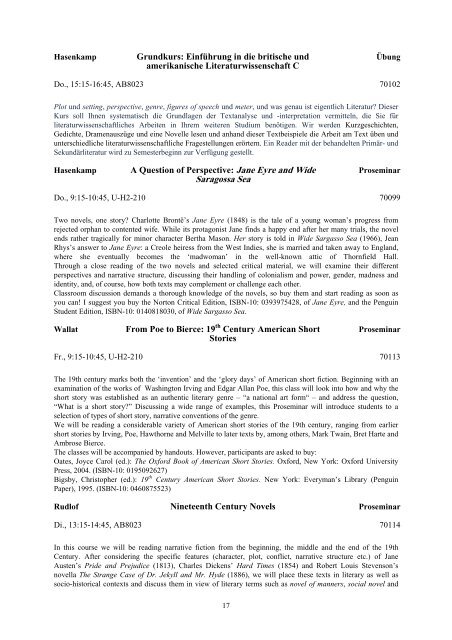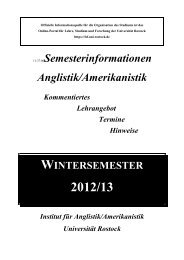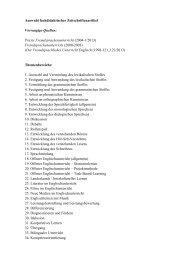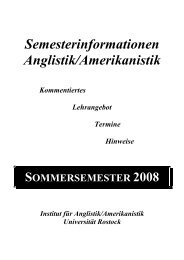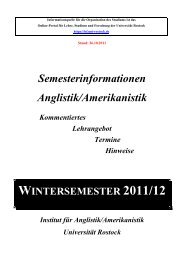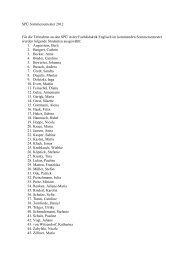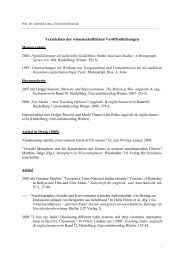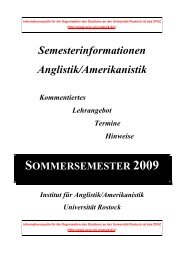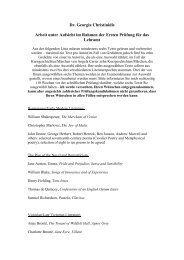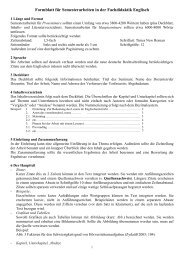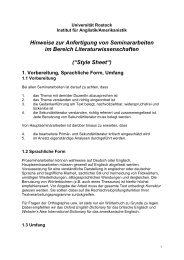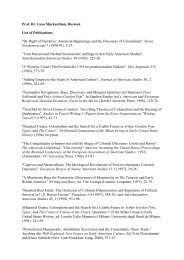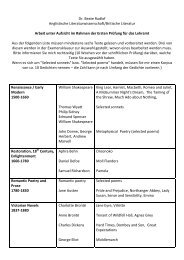Semesterinformationen Anglistik/Amerikanistik - Institut für Anglistik ...
Semesterinformationen Anglistik/Amerikanistik - Institut für Anglistik ...
Semesterinformationen Anglistik/Amerikanistik - Institut für Anglistik ...
You also want an ePaper? Increase the reach of your titles
YUMPU automatically turns print PDFs into web optimized ePapers that Google loves.
Hasenkamp<br />
Grundkurs: Einführung in die britische und<br />
amerikanische Literaturwissenschaft C<br />
Übung<br />
Do., 15:15-16:45, AB8023 70102<br />
Plot und setting, perspective, genre, figures of speech und meter, und was genau ist eigentlich Literatur? Dieser<br />
Kurs soll Ihnen systematisch die Grundlagen der Textanalyse und -interpretation vermitteln, die Sie für<br />
literaturwissenschaftliches Arbeiten in Ihrem weiteren Studium benötigen. Wir werden Kurzgeschichten,<br />
Gedichte, Dramenauszüge und eine Novelle lesen und anhand dieser Textbeispiele die Arbeit am Text üben und<br />
unterschiedliche literaturwissenschaftliche Fragestellungen erörtern. Ein Reader mit der behandelten Primär- und<br />
Sekundärliteratur wird zu Semesterbeginn zur Verfügung gestellt.<br />
Hasenkamp<br />
A Question of Perspective: Jane Eyre and Wide<br />
Saragossa Sea<br />
Proseminar<br />
Do., 9:15-10:45, U-H2-210 70099<br />
Two novels, one story? Charlotte Brontë’s Jane Eyre (1848) is the tale of a young woman’s progress from<br />
rejected orphan to contented wife. While its protagonist Jane finds a happy end after her many trials, the novel<br />
ends rather tragically for minor character Bertha Mason. Her story is told in Wide Sargasso Sea (1966), Jean<br />
Rhys’s answer to Jane Eyre: a Creole heiress from the West Indies, she is married and taken away to England,<br />
where she eventually becomes the ‘madwoman’ in the well-known attic of Thornfield Hall.<br />
Through a close reading of the two novels and selected critical material, we will examine their different<br />
perspectives and narrative structure, discussing their handling of colonialism and power, gender, madness and<br />
identity, and, of course, how both texts may complement or challenge each other.<br />
Classroom discussion demands a thorough knowledge of the novels, so buy them and start reading as soon as<br />
you can! I suggest you buy the Norton Critical Edition, ISBN-10: 0393975428, of Jane Eyre, and the Penguin<br />
Student Edition, ISBN-10: 0140818030, of Wide Sargasso Sea.<br />
Wallat<br />
From Poe to Bierce: 19 th Century American Short<br />
Stories<br />
Proseminar<br />
Fr., 9:15-10:45, U-H2-210 70113<br />
The 19th century marks both the ‘invention’ and the ‘glory days’ of American short fiction. Beginning with an<br />
examination of the works of Washington Irving and Edgar Allan Poe, this class will look into how and why the<br />
short story was established as an authentic literary genre – “a national art form“ – and address the question,<br />
“What is a short story?” Discussing a wide range of examples, this Proseminar will introduce students to a<br />
selection of types of short story, narrative conventions of the genre.<br />
We will be reading a considerable variety of American short stories of the 19th century, ranging from earlier<br />
short stories by Irving, Poe, Hawthorne and Melville to later texts by, among others, Mark Twain, Bret Harte and<br />
Ambrose Bierce.<br />
The classes will be accompanied by handouts. However, participants are asked to buy:<br />
Oates, Joyce Carol (ed.): The Oxford Book of American Short Stories. Oxford, New York: Oxford University<br />
Press, 2004. (ISBN-10: 0195092627)<br />
Bigsby, Christopher (ed.): 19 th Century American Short Stories. New York: Everyman’s Library (Penguin<br />
Paper), 1995. (ISBN-10: 0460875523)<br />
Rudlof Nineteenth Century Novels Proseminar<br />
Di., 13:15-14:45, AB8023 70114<br />
In this course we will be reading narrative fiction from the beginning, the middle and the end of the 19th<br />
Century. After considering the specific features (character, plot, conflict, narrative structure etc.) of Jane<br />
Austen’s Pride and Prejudice (1813), Charles Dickens’ Hard Times (1854) and Robert Louis Stevenson’s<br />
novella The Strange Case of Dr. Jekyll and Mr. Hyde (1886), we will place these texts in literary as well as<br />
socio-historical contexts and discuss them in view of literary terms such as novel of manners, social novel and<br />
17


